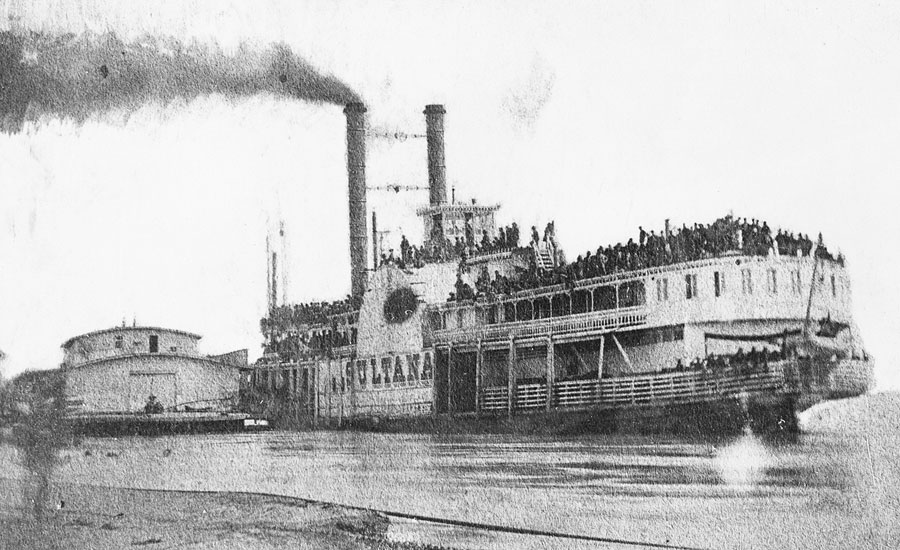April 1865 was a significant month in our nation’s history. Confederate Army Gen. Robert E. Lee surrendered to Union Army Gen. Ulysses S. Grant on April 9 at Appomattox, Va., ending the Civil War. On Good Friday, April 14, President Abraham Lincoln was shot and killed by a stage actor named John Wilkes Booth at Ford’s Theatre in Washington, D.C. Booth escaped the theatre after the shooting and died in a shootout on a farm in Port Royal, Va., 12 days later on April 26.
On April 27, the nation suffered the worst boiler accident in history and its doubtful you ever heard about it. The steamship SS Sultana, enroute from Vicksburg, Miss., to St. Louis, exploded and took more than 1,800 lives. To this day, it is still the worst maritime loss of life, exceeding even the number of victims lost when the HMS Titanic hit an iceberg and sunk on April 15, 1912. The news coverage of the Sultana accident was overshadowed by the assassination of President Lincoln and the end of the Civil War.
How did this happen?
Reports are vague and conflicting as to the cause of the accident. The SS Sultana was a 265-ft., wood-hulled, side-wheel steamship weighing in at 1,719 tons. It was powered by four high-pressure coal boilers that fed two steam engines. The boilers were 18 ft. long and 48 in. in diameter. The ship was constructed in Cincinnati in 1863 by the John Litherbury Boatyard.
It was a state-of-the-art vessel and included such modern safety features as pressure gauges that fused open if the boiler pressure reached 150 psig, 300 ft. of fire hose, 30 firefighting buckets and five firefighting axes. It had a legal capacity of 376 people, of which 80 to 85 were comprised of the crew, leaving space for about 290 passengers.
I know what you are thinking: How could 1,800 people die on a ship that only carried 376 people? Several sources say that Captain J. C. Mason arranged to transport more than 2,000 prisoners of war for a fee of $5 per soldier. It also was reported that the ship carried 2,300 people, 600 times its rating, with only 76 life preservers and two lifeboats. Gene Eric Salecker, author of “Disaster on the Mississippi,” wrote that steamship captains were offering bribes to the officers of $1.15 per POW. As a result, the officers looked the other way when the ships were dangerously overloaded.
Negligence or sabotage?
On April 21, the ship’s engineer found that the two-year-old boilers had bulges and were badly leaking. Captain Mason ordered a temporary patch to be installed. During a layover in Memphis, Tenn., three days later, more leaks were discovered and the ship hired local boilermaker R. G. Taylor to assess the problem. Taylor felt the leaking boilers required extensive repairs but reluctantly agreed to another temporary patch on them.
In addition to the extra passengers, the captain arranged to haul a load of 1,000 bushels of coal, each weighing about 80 lb. The ship was so overloaded the crew had to reinforce the deck because it was afraid it would collapse under the weight of all the passengers. The first clerk and part owner of the ship, William J. Gambrel, warned that if the passengers went too close to one side of the ship, it could capsize.
At 12 a.m., the ship sailed from the port of Memphis. The current was fierce on the Mississippi River that spring, so the captain ordered the boiler pressure increased to overcome the fast river current and the overloaded ship. About an hour north of Memphis, three of the four boilers on the ship exploded, engulfing the ship in flames and flinging passengers into the frigid river. Another contributing factor to the extreme loss of life was that the POWs were malnourished and suffered various injuries and illnesses, making it difficult to save themselves.
Was it really an accident?
A rebel Confederate agent, Robert Louden, on his deathbed confessed the Sultana boiler explosion was due to a coal torpedo he placed on the ship. The coal torpedo was invented by a brilliant Confederate spy named Thomas Edgeworth Courtnay. It was a 4-lb. artillery shell that was cast to resemble a piece of coal and filled with gunpowder. The outside was coated with soot making it look like the coal used to power the boiler. Coal torpedos were usually hidden in the coal pile and the boiler tender would unknowingly shovel it inside the boiler.
It was rumored that coal torpedoes were the cause of boiler explosions on the USS Chenango in April 1864 which killed 33 people and the Greyhound on Nov. 27, 1864. Investigators did not believe Louden’s claim, though, and assumed the overloaded ship, leaking boilers, uncontrolled boiler water level and excessive steam pressure caused the explosion.
At the time of the accident, codes for the construction of ships as well as boilers were almost nonexistent. I like to believe the severity of the accident partially contributed to safer construction of both boilers and steamships. The year after the accident, the Hartford Steam Inspection and Insurance Co. was founded. It was the inventor of the Hartford Loop in 1879 that has been installed on almost every steam boiler since its inception. Maritime safety codes were written and published in 1874 and the Steamboat Inspection Service was created in 1871.
I believe boilers are an amazing feat of engineering as well as a very reliable heating source. The boilers on the SS Sultana only failed after being overloaded by 600%, poorly maintained and possibly bombed. If the boilers had been properly maintained, this accident may not have occurred.



